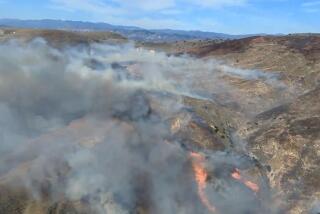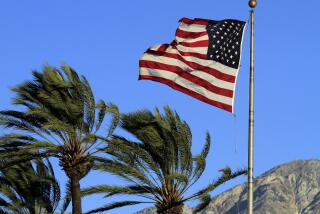Southland prepares for fire season
With temperatures on the rise, Southern California was bracing for the arrival in earnest of fire season.
On Monday, the Los Angeles County Sheriff’s Department’s Altadena station announced that the fire danger level in the Angeles National Forest had risen from “high” to “very high” — the fourth of five levels on the scale. Meanwhile, Supervisor Michael D. Antonovich announced the opening of 55 cooling centers across Los Angeles County to provide relief from the heat for the elderly.
And as if on cue, three brush fires broke out across the Southland on Monday afternoon.
The largest, in the Waterman Canyon area of the San Bernardino National Forest, had burned more than 75 acres by Monday evening. Authorities had begun voluntary evacuations and closed California 18 in both directions between 40th Street in San Bernardino and California 138, the U.S. Forest Service said. The fire was about 30% contained.
A second brush fire in Montebello burned about five acres of an oil field owned by Plains Exploration and Production Co. No one had been injured and no structures were in danger, fire officials said.
And Monday evening, crews made quick work of a small brush fire half a mile from the famed Hollywood sign. That fire started shortly after 6 p.m. in the 3100 block of North Canyon Lake Drive and was knocked down in 24 minutes, the Los Angeles Fire Department said.
Los Angeles County Fire Inspector Tony Imbrenda said the department had already staged a strike team in Santa Clarita on Sunday after a red flag warning went out for the area, and he said fire officials will continue augmenting staff in what he called “hazardous areas.”
Fire Chief Daryl Osby said the Los Angeles County Fire Department has had to make about $50 million in cuts but those cuts have yet to affect the firefighting staff. Other municipalities have taken hits, however, and Osby said the county sometimes needs help from other departments when a “major incident” occurs. He acknowledged that the system could be stressed if multiple fires break out at once or one major blaze burns for a long time.
Subsequently, officials are once again urging residents to clear brush in and around their property.
All the right elements are coalescing to create perfect conditions for wildfires, experts say. Last winter had below average rainfall, the first six months of the year were the warmest ever in the contiguous U.S., and this week, temperatures are expected to rise past the century mark in some areas of Los Angeles County.
“The only thing that’s really saving us here in Southern California is I don’t see any high winds in the forecast,” said Bill Patzert, a climatologist at NASA’s Jet Propulsion Laboratory in La Cañada Flintridge. “But when temperatures escalate, it turns a really dry situation into an incendiary situation. All you need a little trigger. Everything is in place except an ignition.”
Fire season started in late May but Tuesday’s expected heat wave marks the beginning of “a more active time,” according to Eric Boldt, a meteorologist with the National Weather Service. Heat dries out plants, trees and other foliage, which experts said are already low on moisture because winter rainfall in Los Angeles measured only about 9 inches last year — far below the seasonal average.
Between Tuesday and Friday, Boldt said, a high-pressure system will take temperatures above 100 degrees in areas such as the Santa Clarita Valley, the western San Fernando Valley and in desert areas. Boldt said things will cool down by the weekend, but monsoon moisture coming from Mexico could bring thunderstorms on Thursday or Friday. He warned that a little lightning strike is all that’s needed to trigger a big blaze.
“That’s what we’re going to be concerned about in the short term,” he said. “The lightning and the heat are a bad combination.”
The risky conditions have spurred agencies into action.
“There’s fires all over the country,” Patzert said. “The question is, ‘Is California next?’ ”
More to Read
Start your day right
Sign up for Essential California for news, features and recommendations from the L.A. Times and beyond in your inbox six days a week.
You may occasionally receive promotional content from the Los Angeles Times.







